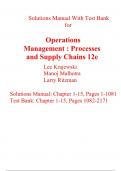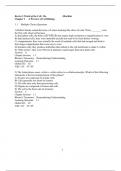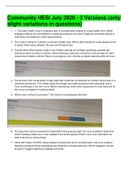Operations Management : Processes and Supply Chains 12e Lee Krajewski Manoj Malhotra Larry Ritzman New York, NY Solutions Manual With Test Bank
for Solutions Manual: Chapter 1-15, Pages 1-1081
Test Bank: Chapter 1-15, Pages 1082-2171 1-1
Copyright © 2019 Pearson Education, Inc. Chapter 1Using Operations to Create Value DISCUSSION QUESTIONS 1. Answering this question demonstrates that processes underlie all of our jobs. What might
be surprising is how man y students would put their job in the category of “other,”
suggesting th at many jobs do not fall neatly into any one functional area. Perhaps many
in the “other” category might best be called “operations” on further reflection.
Customers, both internal and external, are part of each process, and the goal is to manage
the proce sses to add the most value for them .
2. Amazon.com offers a very broad range of services and products at competitive prices. Its
competitive priorities would include fast delivery time, on -time delivery, customization,
variety and low -cost operations. As a b usiness, Amazon.com is actually assembling a
customized basket of goods that must be delivered in a short window of time in a
dependable fashion. Low -cost operations are needed to remain competitive. To remain in
business, Amazon.com needs to maintain high volumes of traffic. Operations strategy
must focus on stock availability and quick, economical, and dependable delivery.
3. The hospital’s commitment to provide attention to patients arriving to the emergency
unit in less than 15 minutes and never to turn a way patients who need to be hospitalized
implies that the facility must be designed to have extra capacity in both beds and
emergency room facilities. It must plan on having extra personnel in the emergency
room and also plan on having additional emergency personnel on call to take care of
unprecedented heavy loads. In line with the mission statement, maximum utilization of
the facilities (i.e., beds and emergency room personnel) would not be one of the
performance objectives for the hospital.
4. FedEx tradit ionally has competed on the basis of fast, dependable delivery. Before the
boom in Internet applications, many businesses relied on FedEx to get things to other
businesses overnight. Now, this need is beginning to diminish as sophisticated systems
are bein g installed to assist companies in planning operations better. And, the Internet
based companies are adding more demands for low cost ground deliveries to specific
customer doors. FedEx, in order to remain competitive with companies such as UPS, has
moved into the door -to-door delivery business, perhaps through acquisition.
Nonetheless, it will require changes to this company’s competitive priorities.
5. Technology Management. To identify a market segment, we need to determine
answers to questions such as: Wh ich colleges and departments currently offer the
subject? What do instructors desire in the way of textbook support? Is there a trend
toward Technology Management courses? Are there other Technology Management Using Operations to Create Value Copyright © 2019 Pearson Education, Inc. 1-2 texts? Some needs assessment can be accomplish ed by survey, but the response rate may be low. A high -investment strategy would be to ask or hire instructors to review and critique a list of topics, then an outline, then a draft. Explicit services include supplying information about the subject in the form of a textbook and instructor support in the form of ancillary publications. 6. It is often not a good idea for a company to try to excel in all of the competitive priorities because it is generally impossible to do so. Mediocrity is a predictable result . The choice and the minimum level of one or more of the competitive priorities are set by the order qualifiers for the particular product or service. The choice of the competitive priorities that the company should emphasize is usually governed by the com pany’s strategy driven by its mission statement and the core competencies that the company wants to harness to seek the best competitive advantage. 7. Core processes should link to a firm’s core competencies. Core processes are those processes that provide t he firm the best competitive advantage. Essential to the definition a firm’s core processes is the concept of “interaction costs.” These costs include the time and money that are expended whenever people and companies exchange services, products, or ideas. If the transaction costs are higher to retain a process within the firm’s organization than to outsource the process, the process should be outsourced. 8. Wendy’s assembles hamburgers to order. When materials are held at the stage just before final assembl y, they can be used to complete a wide variety of different sandwiches. Because no finished -goods stock exists, when customers say, “Hold the sauce,” there is no delay or waste of materials. Service clerks specialize. One clerk takes orders and payment. Ot hers fill portions of the order. Orders are processed in single file. Throughput is normally restricted by transactions at the cash register. At busy times, throughput is increased by splitting the bottleneck operation. One clerk takes customer orders, ano ther receives payment. The Wendy’s operation has some characteristics of assembly. Therefore, the impact of new menu items on the production operations must be carefully considered. 9. Grandmother’s Chicken. a. Kathryn Shoemaker’s strategic plans include the fo llowing: Product and service plans: Should the new location offer a new mix? Competitive priorities: If the product mix and service mix are different at the new location, the thrust could be on low volumes and high quality. Quality management: Should the goal be reliability or top quality? Process strategy: What processes will be needed to make chicken dinne rs in the addition or new facility? New technologies: Is it time to automate? Is this why there is a problem in service times? Capacity: How large should the addition or new facili ty be? Location: Should we locate in Uniontown or expand in Middlesburg? Using Operations to Create Val ue CHAPTER 1 Copyright © 2019 Pearson Education, Inc. 1-3 b. Attitudes toward nutrition could change the demand for chicken. Competitors such as Boston Market may be planning to move to Uniontown or even M iddlesburg. There may be a trend toward demands for ever -faster service, which cannot be supported by the processes specified in the “unique recipe.” The economy of Uniontown might not be supportive of restaurant services. Shoemaker should also consider th e availability of key resources, such as servers, whole chickens, spices, and cooking oil. Will Uniontown labor organize? c. The possible distinctive competencies at Grandmother’s Chicken Restaurant include the “unique recipe,” the homey atmosphere, and frien dly, prompt service. 10. Wild West, is recognizable as US WEST, which was bought out by Qwest in a hostile take over in June, 2000. But many other “Baby Bells” are in a similar position. a. Strategic plans include reducing overhead, reengineering operations, and investing in new technologies to meet competition. The “do -nothing” option of remaining a local monopoly telephone company is not viable because of competition from cable systems and wireless systems that are capable of business and personal communication . If the mission is too broad, Wild West should sell its financial services and commercial real -estate businesses. Those businesses do not match their distinctive competencies. b. One environmental issue is whether communication, like health care, will be vie wed as a “right” and therefore should be free. A significant portion of Wild West’s business is governed by regulatory agencies. Customer service in their core business is essential to maintaining a favorable regulatory environment. Other business opportun ities, such as manufacturing and providing information services, are prohibited by the same court order that formed the “Baby Bells” from AT&T. c. Wild West’s distinctive competency is in connecting people (or machines) for the purpose of communication. A wea kness is high overhead inherited from the era of telecommunication monopoly. 11. Although the answers may vary depending on the “niche” elements of the business, the competitive priorities would include on -time delivery, low -cost operations, and customization . The latter competitive priority comes from the capability to assemble unique “baskets” of food items for each customer. There may be a need to coordinate a given basket between two different stores. Capabilities to develop would include information syste ms and Web page design, efficient scheduling of delivery trucks (which must first collect the items in the basket and then deliver them to the customer’s door), and an adequate fleet of trucks with drivers.






